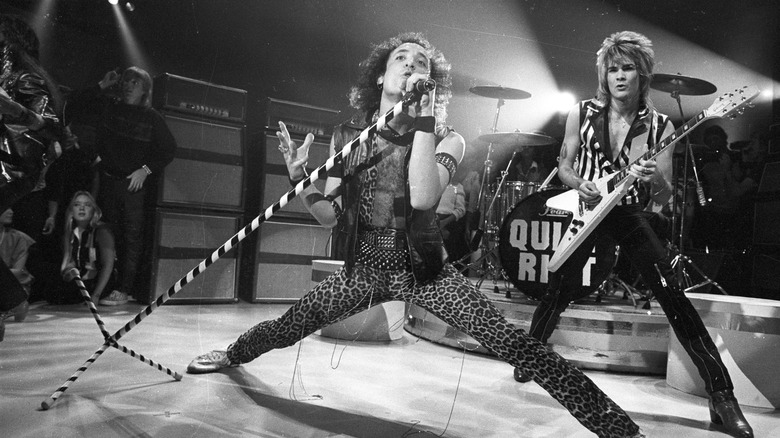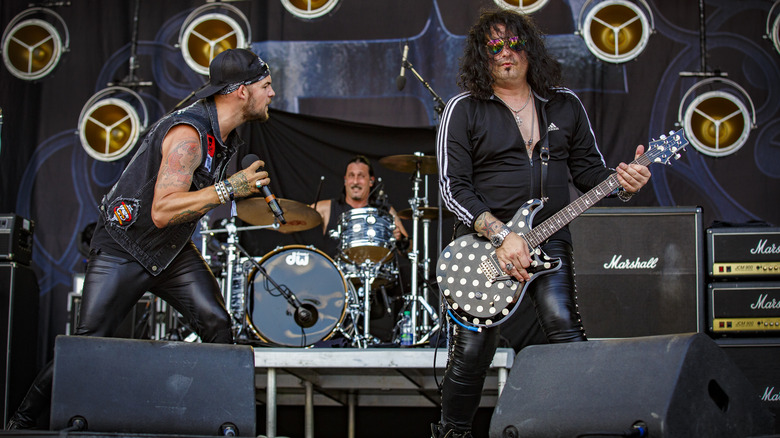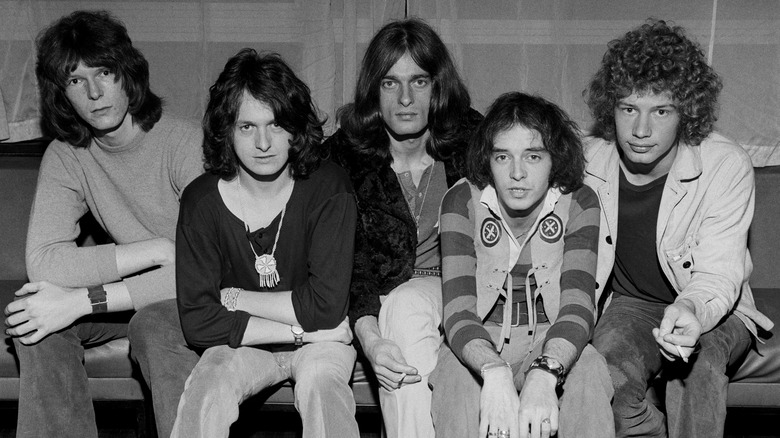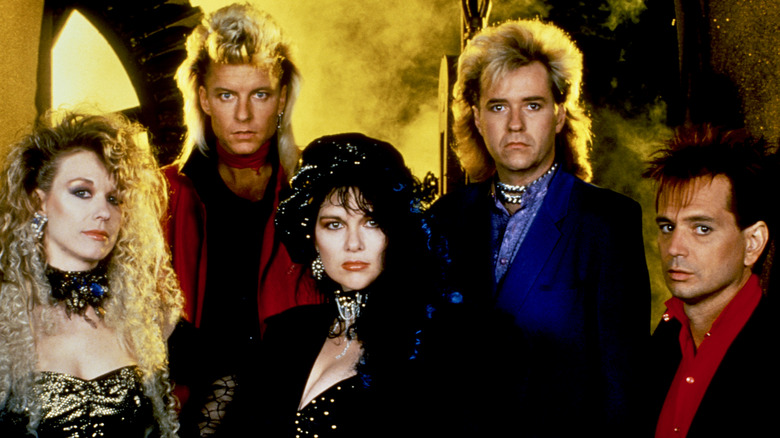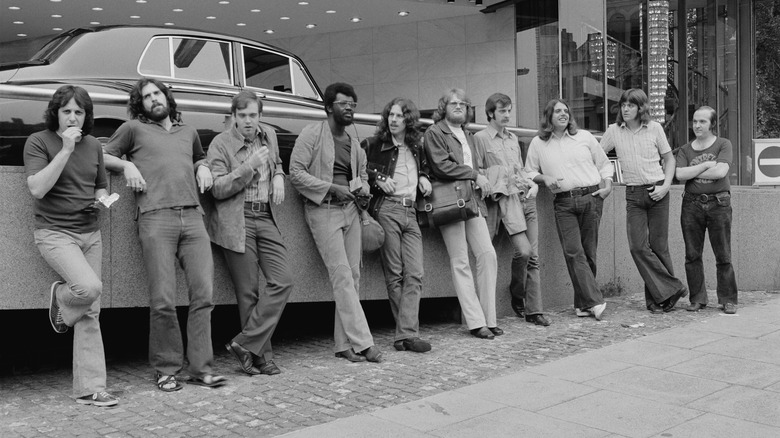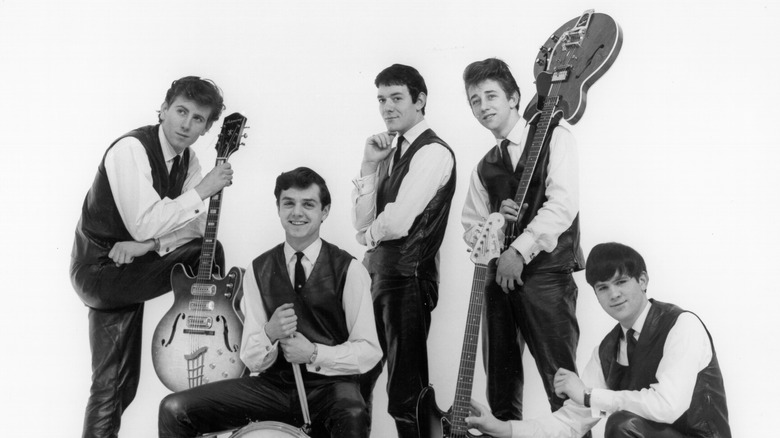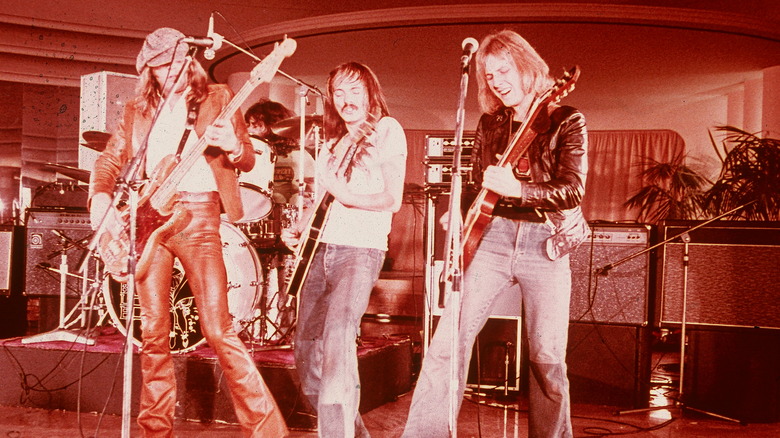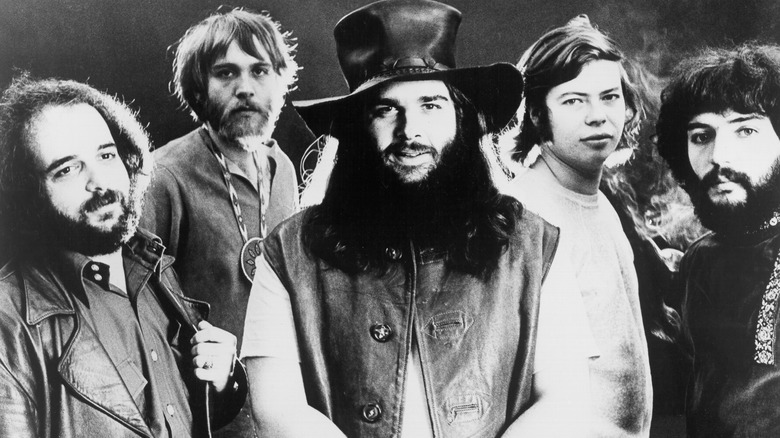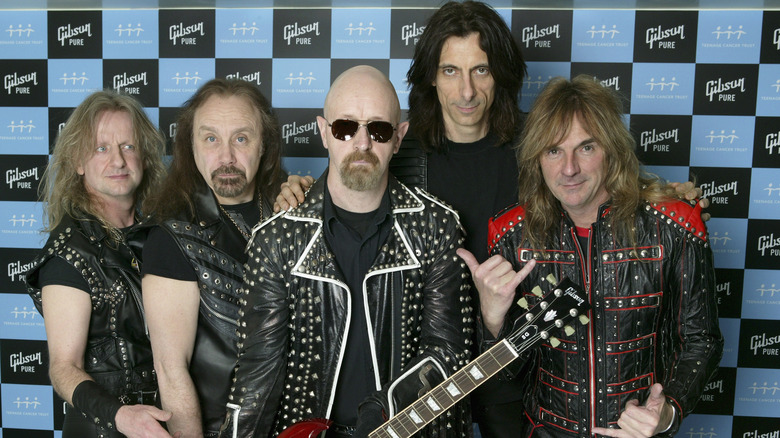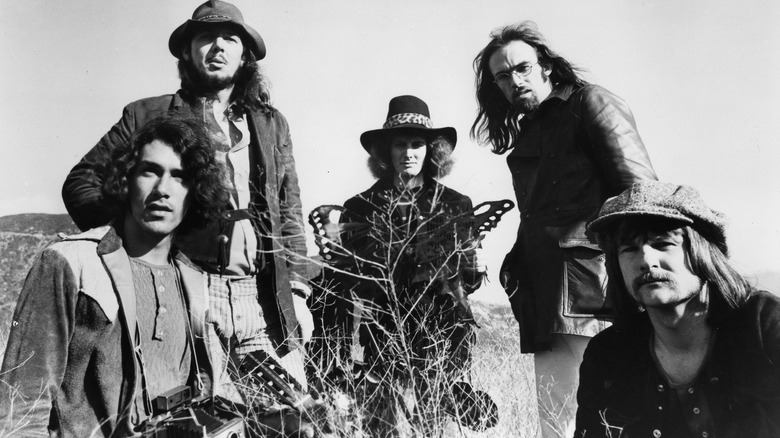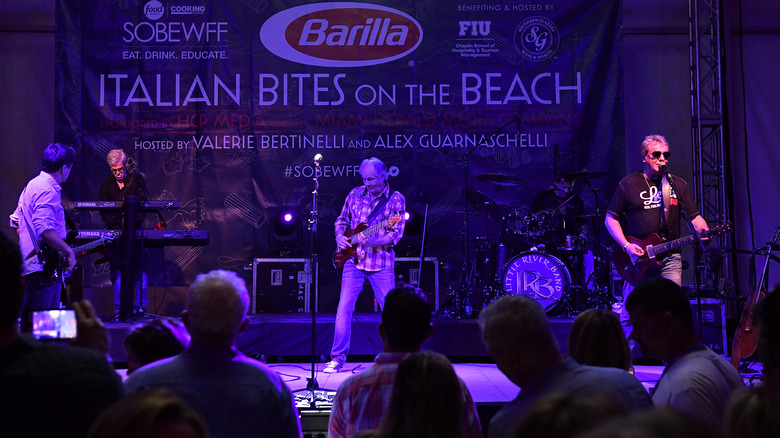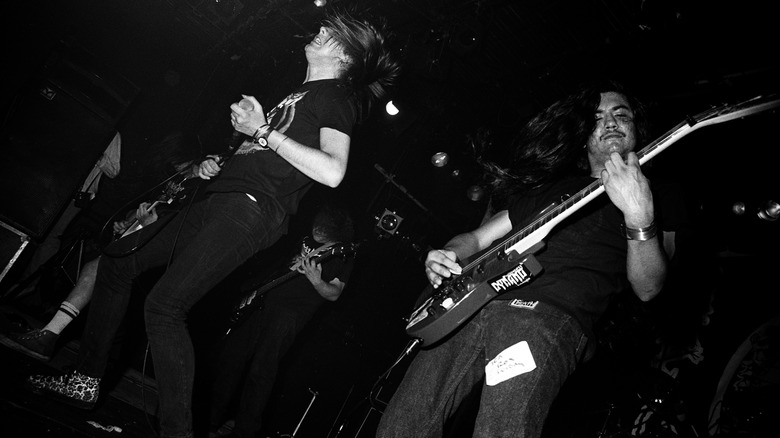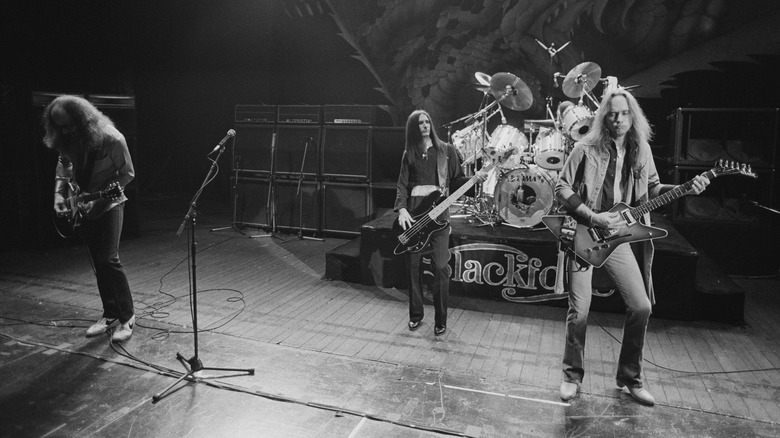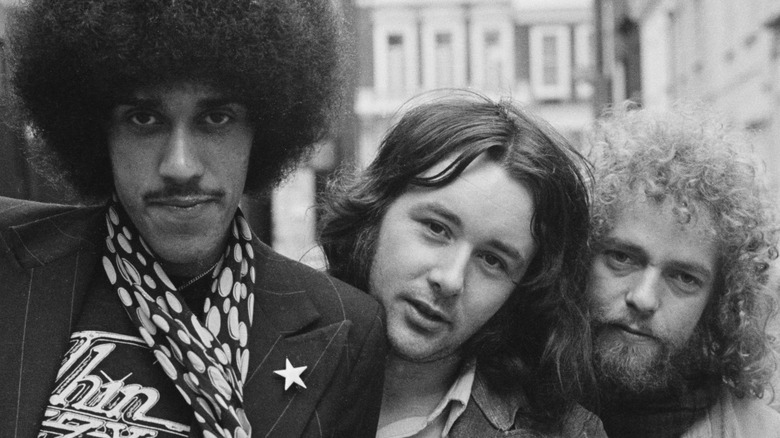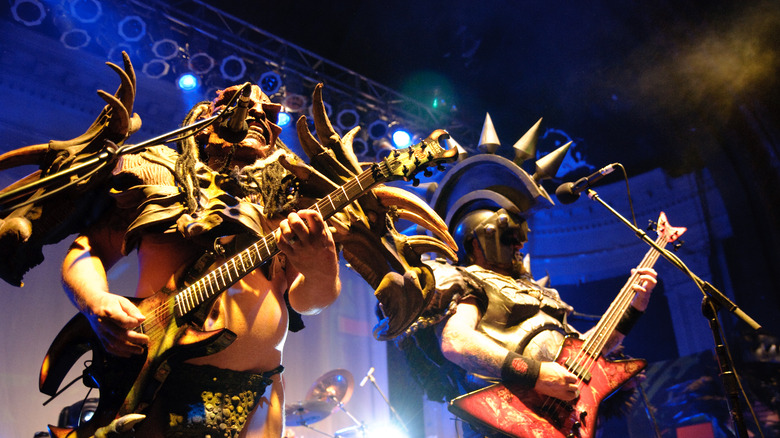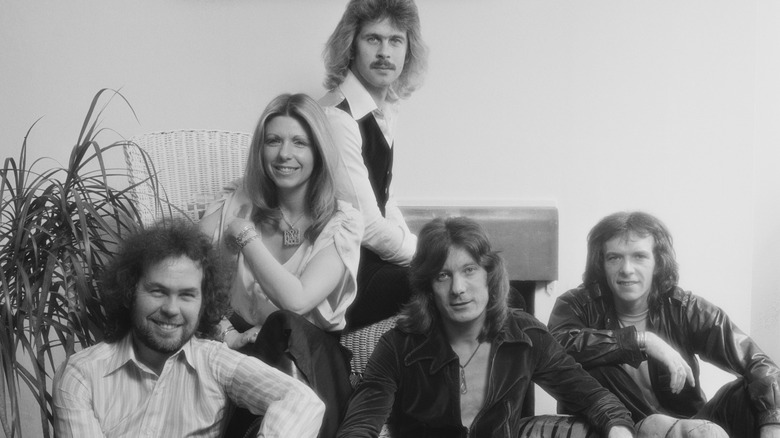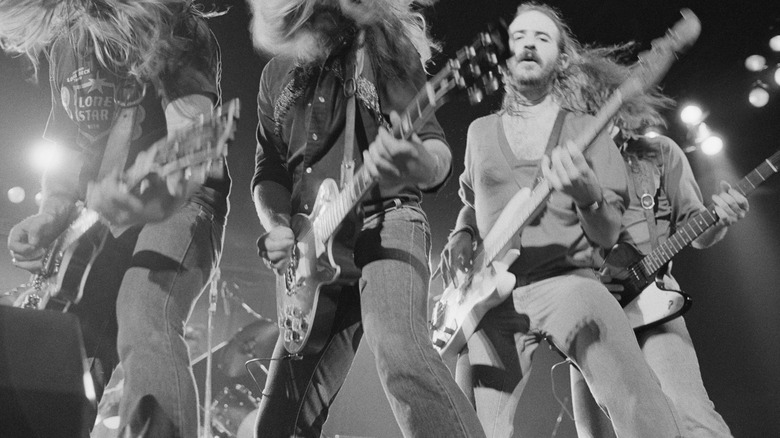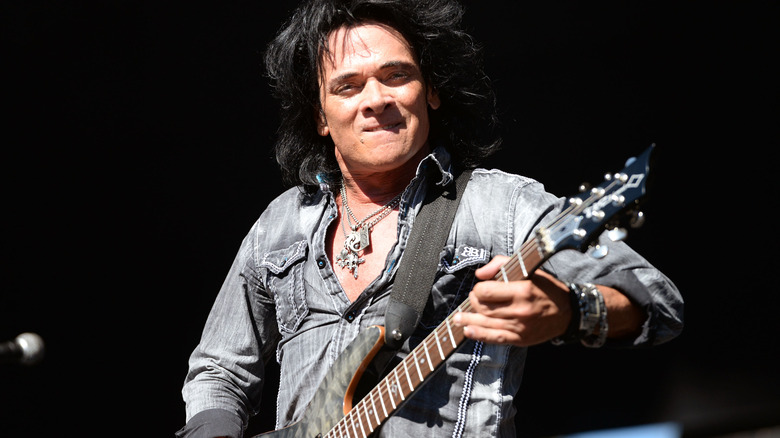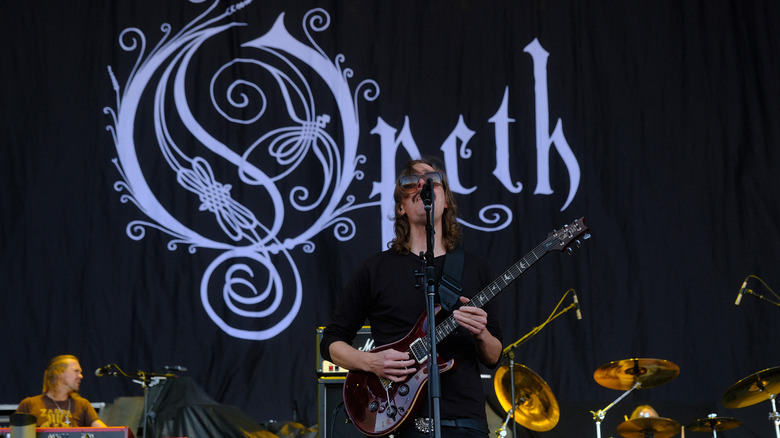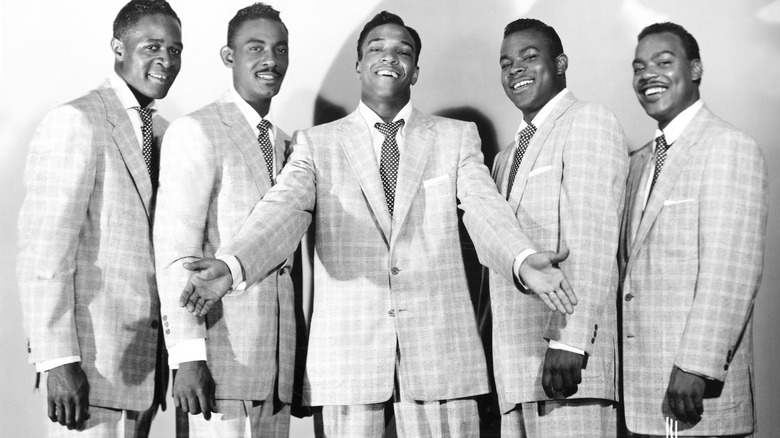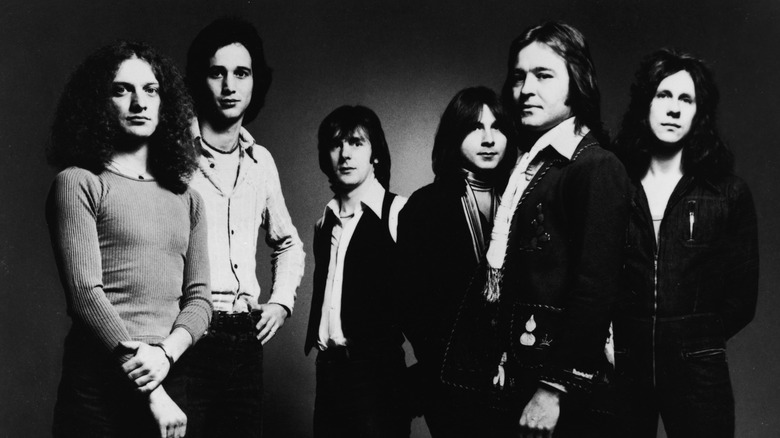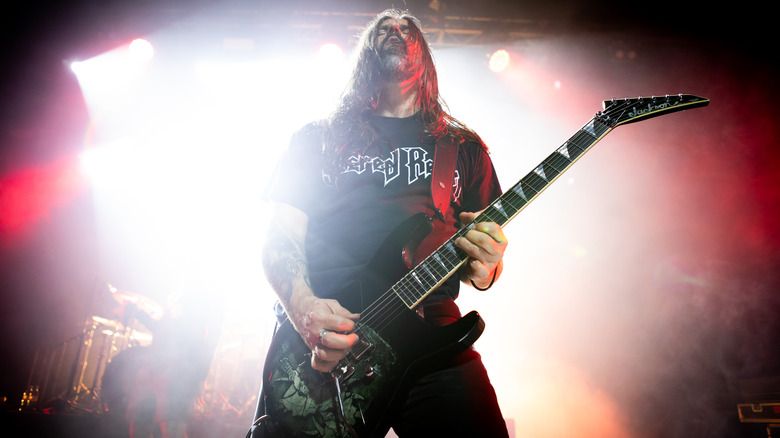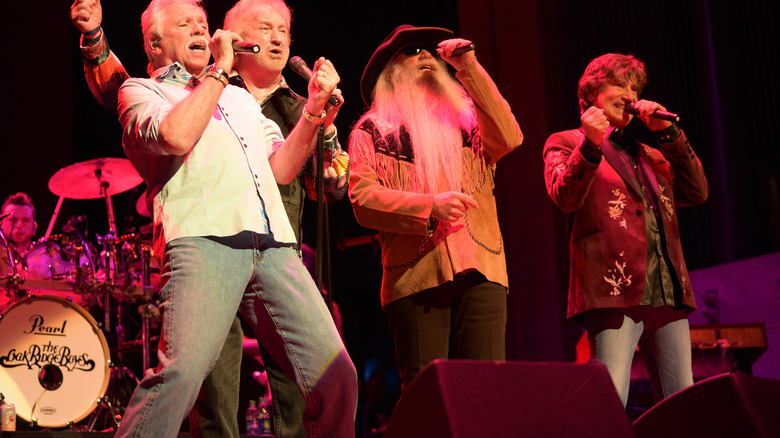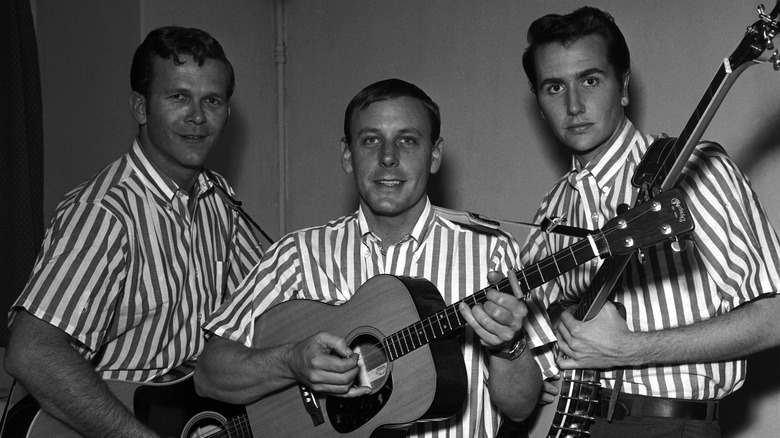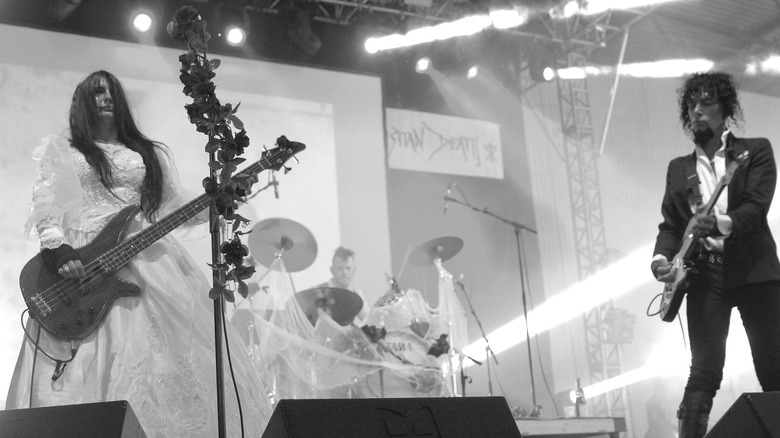Bands With No Original Members Left In Them
According to The Philosophy Foundation, there's a concept in metaphysics called The Ship of Theseus that asks a simple question — if you slowly replace every piece of a ship over time so that nothing original remains, is it the same ship? If not, when exactly is the turning point?
That might seem like some pretty out-there stuff to ponder, but it has a very practical application — figuring out when a rock band is no longer the same band but something completely new. In other words, if a band has replaced every founding member over the years, is it still the same band, or has it become a very complicated tribute band?
Successful rock bands tend to stick around for a long, long time — The Rolling Stones have been active for almost 60 years — and that means they suffer a pretty high rate of attrition. Age, burnout, personality conflicts, and mortality all peel away members over time, but if there's money to be made those members are usually replaced, and the band carries on. But when does a band stop being the same band and become something new? What if every single founding member of the band is gone?
It's hard to believe anyone would consider a band without Keith Richards and Mick Jagger to be The Rolling Stones — but here are 12 bands with no original members left in them.
Quiet Riot: No original members since 2007
Quiet Riot burned very brightly for a very short period of time, but the band has a surprisingly deep history. According to Ultimate Classic Rock, Quiet Riot was originally founded all the way back in 1973 by guitarist Randy Rhoads, who would go on to superstardom with Ozzy Osbourne, along with bassist Kelly Garni. The original lineup also included Drew Forsyth on drums and Kevin DuBrow as lead singer. This version of the band managed two albums but didn't work well together — Ultimate Classic Rock confirms that Garni once literally threatened to murder DuBrow, which explains why that version of the band broke up in 1980.
Luckily for heavy metal fans, DuBrow reformed the band with drummer Frankie Banali, bassist Rudy Sarzo, and guitarist Carlos Cavazo, and even got Rhoads' blessing to keep using the name. The result was "Metal Health," the band's biggest and best-known album. That means that as Classics Du Jour points out, as far back as 1982, DuBrow was the last original member in the band. The band went through several more incarnations over the years, but after DuBrow passed away in 2007 (per Billboard), the band working under the name Quiet Riot has only a thin connection to the original band — technically bassist Chuck Wright is the oldest member, but Loudwire points out he only played on two songs on "Metal Health."
Yes: No original members since 2015
Formed in 1968 by Jon Anderson, Chris Squire, Peter Banks, Tony Kaye, and Bill Bruford, Yes is one of those bands that has actually been several different bands over the course of its history — with each new version of the band featuring new lineups. In fact, according to Ultimate Classic Rock, there have been nearly 20 musicians in Yes at some point during the band's history — and according to Ultimate Classic Rock, since the 2015 death of co-founder Squire there are no original members in it at all.
That doesn't mean the current version of the band is completely divorced from the progressive rock legends who gave us songs like "Long Distance Runaround" (via vzqk50CL) or the more pop-oriented 1980s version of the band. As noted by Loudwire, current member Steve Howe's involvement with the band dates back to 1970 (per Ultimate Classic Rock), and Alan White first joined the band in 1972, according to Holy City Sinner.
One element of confusion with Yes is the fact that almost all of their best-known songs were sung by Jon Anderson, whose distinctly high-pitched voice and New Age-influenced lyrics helped define the band's sound. Anderson is still alive and active, and as Classics Du Jour points out, was part of a group called Anderson, Rabin and Wakeman, featuring two other former members of Yes, Trevor Rabin and Rick Wakeman. They were legally prevented from using the name Yes but performed Yes songs in concert until their breakup in 2020, per Ultimate Classic Rock.
Heart: No original members since 1982
When you think of Heart, you think of the Wilson sisters — Ann with the impossibly huge voice, and Nancy with the shredding guitar licks of songs like "Barracuda" (via thebandheart). But neither Wilson sister is an original member of Heart — although they took over almost immediately after they joined.
As noted by Ultimate Classic Rock, Heart's history goes back to 1967, when guitarist Roger Fisher and bassist Steve Fossen formed a band called The Army. Over the next few years, the band's name and lineup changed frequently, at one point becoming White Heart, then briefly Heart. In the early 1970s, Ann Wilson joined the band and the name changed again — to Hocus Pocus. Nancy joined the band shortly afterward, and the band became Heart for once and for all (per AllMusic).
By the time that classic 1970s lineup saw their big break come in 1975 with the release of "Dreamboat Annie" — which featured the hits "Magic Man" and "Crazy on You" (via SuperKevinheart) – it was a very different band than the one Fisher and Fossen had founded. The band remained a force throughout the 1970s, but by the early 1980s they'd run out of steam. Fisher left in 1980, and Fossen departed in 1982, leaving no original members in the band. The Wilsons set about re-inventing Heart, transforming it into a 1980s hard rock outfit and releasing the ultimate comeback album, 1985's "Heart," without a single founding member's contribution.
Blood, Sweat and Tears: No original members since 1968
As Al Kooper recounts in his memoir, "Backstage Passes and Backstabbing Bastards," Blood, Sweat and Tears was formed in 1967 with founding members Kooper, Jim Fielder, Fred Lipsius, Randy Brecker, Jerry Weiss, Dick Halligan, Steve Katz, and Bobby Colomby. You might think with that many founding members some of them must have stuck around, but you'd be almost totally wrong.
Led by Kooper, the band quickly got to work on recording songs that were definitely unusual for rock and roll — simply having a full-on horns section set the band apart from everyone else. They released their first album, "Child is Father to the Man," in 1968 to moderate success. But the band fell apart almost immediately due to simmering tensions between the members. Kooper, Brecker, and Weiss left the band (via Sam Houston State University) before work on their second album had even started, setting some sort of record for a breakup as well as a precedent– since then, almost 200 people have officially been members of Blood, Sweat and Tears (per Classic Bands).
Over the course of those lineup changes and legal battles, all of the original members of the band exited and were replaced, then replaced again. As noted by Ultimate Classic Rock, the one thread holding everything together is Colomby, who still owns the band name and rights to the music. Technically Colomby isn't in the band anymore, though — he manages and produces, hiring musicians to fill out the band as needed.
The Hollies: No original members since 1999
Named in honor of rock n' roll legend Buddy Holly, The Hollies were formed in England in 1962 by Allan Clarke and the legendary Graham Nash, according to Rolling Stone. They eventually added Tony Hicks, Bobby Elliott, and Bernie Calvert to form the lineup that gave us classic hits like "Bus Stop" (via 74sodapop). The Hollies are arguably criminally underrated as a 1960s band — as author Peter Doggett points out in his book "Crosby, Stills, Nash and Young," they were huge superstars in England and probably second only to The Beatles in terms of hit songs and influence.
After years of success, Nash and Clarke began having creative differences, which came to a head when the band rejected Nash's song "Marrakesh Express" (considering that song is still a staple of classic rock radio, The Hollies might have some regrets about that). As reported by Ultimate Classic Rock, Nash left in 1968 to form a little band called Crosby, Stills and Nash. Clarke wanted a solo career and left the band in 1971, only to rejoin in 1973 (per AllMusic) when a song he'd co-written for the Hollies, "Long Tall Woman in a Black Dress" (via The Hollies) became a huge international hit. Classics Du Jour notes that Clarke didn't just leave the band again in 1999, he retired from music altogether. The band today is led by Hicks and Elliott, who are very, very close to being original members — but not quite.
Humble Pie: No original members since 1991
The term "super group" has lost some of its luster in an age when every pop song has a few bars devoted to a superstar rap artist, and vocalists routinely guest on each other's songs. But back in the 1960s, it was a novel idea when Small Faces guitarist Steve Marriott brought together bassist Greg Ridley of the band Spooky Tooth, Peter Frampton from The Herd, and teenage drumming phenomenon Jerry Shirley to form Humble Pie. Considered one of the first super groups, the band had a string of hit songs, including the timeless classic "30 Days in the Hole" (via ghostryder8567).
As noted by Classics Du Jour, Frampton left in 1971 and would eventually release one of the most successful live albums of all time. Louder tells us the band continued until 1975, Marriott and Shirley reformed it in 1979, but the band fell apart again in the early '80s. According to Amoeba Music, Shirley secured the rights to the name Humble Pie in 1989 and reformed the band. There was some hope that Marriott and Frampton might join again, but as Ultimate Classic Rock reports, Marriott died tragically in a fire at his home in 1991, ending that dream.
These days you can still go see Humble Pie in concert — but you won't see any original members in it. Drummer Shirley still owns the name, and he manages the band but doesn't tour with them.
Canned Heat: No original members since 1981
You probably instantly recognize Canned Heat's most famous song. "Going Up the Country" (via Canned Heat – Topic) is a staple of classic rock playlists, movie soundtracks, and commercials, the sort of song that has become a foundational piece of the background noise of American life.
As reported by Ultimate Classic Rock, the band was formed in 1965 by Alan Wilson and Bob Hite, who were huge fans of American blues music. From the very beginning, the band's lineup was in flux — the first musicians hired left within days. But appearances at the Monterey Pop Festival in 1967 and their iconic performance at Woodstock in 1969 made them superstars.
Sadly, as Classics Du Jour reports, Wilson died of a drug overdose in 1970. The band powered on with Hite until 1981, when Hite also died of a drug overdose in the darkest way possible. As Louder reports, Hite — who had grown to be over 300 pounds and was nicknamed The Bear — regularly passed out due to his drug abuse, so when he collapsed after snorting a vial of heroin the band just left him in the dressing room and did a gig without him. Then they put him in the back of their tour van and left him there — where he died a few hours later.
The band never broke up — it just keeps hiring new members and plugging on. It's currently anchored by drummer Adolfo "Fito" de la Parra, who dates back to 1967 with the band.
Judas Priest: No original members since 1973
Judas Priest are legends of heavy metal, with songs like "Livin' After Midnight" and "The Ripper" (via Judas Priest) regarded as classics of the genre. And the band is still going strong, though it has exactly zero original members — but that shouldn't be a surprise, since the band hasn't had any original members for the vast majority of its existence.
As reported by Ultimate Classic Rock, the band was formed in 1969 by lead vocalist Al Atkins and bassist Brian Stapenhill, guitarist John Perry, and drummer John Partridge. They were originally a blues-rock band with an entirely different sound. In fact, according to Neil Daniels' book "The Story Of Judas Priest: Defenders Of The Faith," guitarist K.K. Downing, who came to define the band's sound along with eventual lead singer Rob Halford, auditioned for the band — and was rejected by Atkins.
The band broke up in the early 1970s, and Atkins joined a band called Freight featuring Downing on lead guitar (per Ultimate Classic Rock), which took on the Judas Priest name. But by 1973 the only original member left was Atkins, and the band's lack of success convinced him to give up, so he quit. Halford joined, setting the stage for the band's most successful period as their sound evolved into harder rock. From that point on, not a single founding member has had anything to do with the band.
Iron Butterfly: No original members since 1999
In the annals of one-hit wonders, there's a special place for Iron Butterfly. Founded in 1966 by Doug Ingle, Jack Pinney, Greg Willis, and Danny Weis (per Exposé), the band is famous for exactly one nearly endless song — the extremely 1960s, 17-plus-minute-long "In-A-Gadda-Da-Vida" (via pauloget). But that song is so iconic and instantly recognizable it's provided a living for the band since its release in 1968, selling 30 million copies since its release, according to The Saturday Evening Post.
And the people who have made their living off of that one song at some point over the last 50-plus years is a pretty long list. Iron Butterfly rivals Blood, Sweat and Tears for sheer number of people who have been in and out of it — more than 65 musicians have been official members over the years, says The Morning Call. As noted by Classics Du Jour, the band started a revolving door of members almost immediately — their guitarist and bassist both left after the first album. The band broke up in 1971 but reformed in various incarnations over the years, as "In-A-Gadda-Da-Vida" racked up tens of millions of sales.
As Classic Bands notes, the band reformed with Ingle and Ron Bushy, who joined the band a few months after its founding. Ingle retired in the late '90s, according to Iron Butterfly, leaving Bushy in charge of the group. Iron Butterfly is essentially a tribute band at this point, though Bushy almost counts as an original member.
The Little River Band: No original members since 1998
Sometimes bands bring in musicians to fill in gaps and the new player slowly takes over the band. That's what happened with one of the first Australian bands to crack the American market, The Little River Band.
According to VMP, The Little River Band formed in 1975 as a bit of a supergroup in its native Australia, as founding members Beeb Birtles, Graham Davidge, Graeham Goble, Dave Orams, Derek Pellicci, and Glenn Shorrock were all pretty established performers in their home country. As Allmusic notes, the band enjoyed almost immediate success with their first album and ended the 1970s as one of the biggest-selling bands around.
The 1980s weren't so kind, however. As noted by Ultimate Classic Rock, Wayne Nelson joined the group in 1980 as a new bassist. He also sang lead on one song. The band went through a prolonged period of mutation as Shorrock, Birtles, Goble, and Pellici were all gone by 1992 (Orams had left almost immediately after the band's founding). The original members continued to shuffle in and out of the lineup until 1998, when they all left more or less permanently, per AllMusic.
Wayne Nelson took over lead singing duties and today pretty much runs the band. The current lineup features musicians who only date back to 2004 at the earliest.
Napalm Death: No original members since 1986
Unless you're into grindcore metal, you might not know much about Napalm Death, but within the heavy metal community the band is legendary and influential: Metal Injection tells us the band is also the record holder for shortest song ever recorded, with the 1.316 second-long "You Suffer" (via Mincecoreforpassion). They've also been around for more than 40 years, having been founded in 1981. Well, a band called Napalm Death was founded in 1981. None of the people in the band today were there at the time.
Per Oxford Reference, the band was launched in 1981 by Nic Bullen and Miles Ratledge, who brought in guitarist Simon Oppenheimer (per Noogatoday). After a few years of lineup changes, demo recordings, and live shows, Bullen and Ratledge began to evolve in different musical directions, per the Birmingham Music Archive, and the group split into two with Bullen leading the official Napalm Death. Bullen's frustrations continued until he quit the band in 1986, just after recording a final demo that became side one of the band's first official album, "Scum," released in 1987.
As Burning Ambulance notes, the band's lineup has been steady ever since — but the fact is this band wasn't established as an influential classic until all the original members were gone.
Blackfoot: No original members since 2012
Blackfoot has had an extremely complicated history. Originally formed in 1969 (per Ultimate Classic Rock) with Rickey Medlocke, Greg T. Walker, Charlie Hargrett, and Jakson Spires, the group chose the name Blackfoot to honor the Native American heritage many of the members shared. But as Puresouthernrock reports, before the group could really gain any traction, Medlocke was asked to join Lynyrd Skynyrd and didn't hesitate for a second, so Blackfoot was put on hold for a few years.
Medlocke, Walker, Hargrett, and Spires reformed the group in 1974 and finally released their first album, "No Reservations." This kicked off a stable and successful period for the band, during which they released their signature songs "Highway Song" (via Queenigma) and "Train, Train" (via killthedead23), both of which were chart hits for the band.
Their fortunes turned in the mid-1980s, and the band broke up in 1986, according to Bobby Barth's biography. Medlocke continued on with 1987's "Rick Medlocke and Blackfoot" (via AllMusic) which tried for a more modern sound and in the 1990s tried to mold the band towards a more hard rock approach with new members. Then, as Ultimate Classic Rock reports, Medlocke was once again invited to join Lynyrd Skynyrd and once again left Blackfoot without a second thought.
Today, the other founding members of the band are passed on. Medlocke rebooted the band in 2012 — with himself as manager and producer and hired hands playing the instruments. It's essentially a totally different band, with a sound the founding members wouldn't recognize.
Thin Lizzy: No original members since 2013
Formed by Brian Downey and Phil Lynott — friends since childhood — in 1969 (via Ultimate Classic Rock), by the late-1970s Thin Lizzy had established itself as one of the most ferocious and successful rock bands in the world. As noted by The Guardian, their twin-guitar sound peaked with the release of their 1976 album "Jailbreak," which contained their biggest and most-recognized hit, "The Boys are Back in Town" (via James Cooper).
But as noted by Ultimate Classic Rock, by the early 1980s the band was struggling. Between the changing sound of pop music and Lynott's growing heroin addiction, the band simply couldn't survive, and broke up in 1983. In 1986, Lynott passed away, and that seemed to be that for Thin Lizzy. Founding member Downey put together a new lineup in the mid-1990s, but Loudwire reports that Downey himself left the band in 2013, leaving Thin Lizzy with zero original members, though guitarist Scott Gorham joined the band in 1974 and played on their most famous and successful albums.
Louder reports that after Downey left the band, Gorham formed Black Star Riders as a way to create original music that was distinct from Thin Lizzy, but left that group in 2021 to concentrate on Thin Lizzy, which means you'll likely see the band be more active on the touring scene, original members or not.
GWAR: No original members since 2014
As noted by The Guardian, GWAR is best described as a sort of "punk-rock opera." Known for wearing outrageous latex costumes and adopting stage names like Oderus Urungus or Techno Destructo, non-fans have been wondering if they should take GWAR seriously as a band ever since their formation in 1984. But, as noted by The Commonwealth Times, GWAR was always meant to be a form of performance art that melded heavy metal music with a parodic sense of the absurd — it's always been purposefully over the top.
Making things even more complex is the ever-changing lineup of the band, with more than three dozen performers having been part of GWAR at one time or another. All that turnover means it's not too surprising that, according to Ultimate Classic Rock, there are no longer any original members in GWAR at all, and haven't been since the 2014 death of Dave Brockie, the aforementioned Oderus Urungus.
How much this matters is an open question. Since the members of GWAR are hidden behind ludicrous latex costumes and outrageous stage names, and often cycle in and out of the band constantly, you might not even know who, exactly, is playing on stage if you catch a GWAR show. All that's guaranteed is that it won't be any of the original members.
Renaissance: No original members since 1971
As noted by Boomer Magazine, legendary rock group The Yardbirds led directly to several other seminal rock bands, with former Yardbirds forming Led Zeppelin, the Jeff Beck Group, Cream, and a band called Renaissance — formed by former Yardbirds members Keith Relf and Jim McCarty. Last.fm reports that the original lineup included Relf's sister, Jane, keyboardist John Hawken, and bassist Louis Cennamo. Both Keith and Jane Relf were gone after recording two albums, so McCarty reformed the band with an entirely new lineup by 1971, including Annie Haslam as the new lead vocalist, according to Ultimate Classic Rock. Then McCarty himself left the band, and the lineup began to stabilize. By 1975, with the release of their classic album "Scheherazade and Other Stories," the band had established itself as a leading progressive rock band, per Ultimate Classic Rock.
But the tumultuous early years of the band means that the original lineup lasted just about two years, and the vast bulk of the band's material — including its most commercially successful work in the late 1970s — had nothing to do with any of the founding musicians. Even more complicated, the band Haslam is currently touring with are all musicians she recruited in the late 2000s, so she's the sole link to the earlier years of the band.
Molly Hatchet: No original members since 2017
As noted by American Songwriter, Molly Hatchet were never the biggest band in the world, but they were very influential in the genre of Southern rock. As reported by the Sun-Sentinel, the band was pretty successful in their time, logging several million-selling albums, including 1979's "Flirtin' With Disaster," which hit No. 19 on the Billboard charts and has sold more than 2 million copies (via the RIAA).
If that makes you want to see Molly Hatchet in concert, you're in luck — the band is still on the road regularly, per their website. Except you won't be seeing a single original member on the stage, because as noted by Billboard, the last living original member, Steve Holland, passed away in 2020. Holland actually left the band in 1984, but as reported by Louder, founding member Dave Hlubek passed away in 2017, officially leaving the band with zero original members — vocalist Danny Joe Brown died in 2005, guitarist Duane Roland died in 2006 (per UPI), bassist Banner Thomas died in 2017 (per Ultimate Classic Rock), and drummer Bruce Crump died in 2015 (per Loudwire).
That means there's no possibility of ever seeing Molly Hatchet in its true form ever again — according to Las Vegas Magazine, the longest-serving member in the current lineup is guitarist Bobby Ingram, who joined the band in 1987.
Autograph: No original members since 2022
If you were alive and rocking in the mid-1980s, you probably remember the band Autograph and their one-hit song, "Turn Up the Radio" (via AutographVEVO). And if you're still paying attention to them, you might have noticed they released a new album, "Beyond," in November of 2022 (per Metal Express Radio) — but if you catch the band on tour in support of the album, you won't see any of the original members. Founding bassist Randy Rand, who was the last original member active in the band, passed away in April 2022, according to Deadline.
After breaking up in 1989, the band reformed in 2013 with original members Rand, Steve Lynch, and Keni Richards (who passed away in 2017). That incarnation released two albums, according to Loudwire, but Lynch left the band again in 2019. After Rand's death, the band kept going without any original members — and a legal fight broke out between Lynch and the current lineup, over ownership of the band's trademark and name.
According to Ultimate Classic Rock, Lynch claims that the band is contractually obligated to have at least one original member, to be able to use the name Autograph. As far as Lynch is concerned, Autograph is now more of a tribute band than the real thing, and are only in it for the money.
Opeth: No original members since 1992
Opeth may not be a household name, but they've had a significant impact on the genre of progressive metal. As noted by Guitar World, the band has its origins in Death Metal, with a vocal style spiced with "death growls, " per Last.fm. But their style has evolved to include intricate arrangements and a surprisingly wide variety of instrumentation, and they've been very successful too, with four albums landing in the Top 40 on the Billboard 200 Albums chart.
Unfortunately, they've also embraced a wide variety of band members — in fact, according to Loudwire, the band hasn't had an original member in it since 1992 — just two years after the band was founded. As Louder explains, at the band's very beginning in 1990, lead singer David Isberg invited Mikael Åkerfeldt to join the band as its new bassist — without telling the current bassist, or any of the other members. A fight broke out about it, and every other band member left the group.
Isberg and Åkerfeldt forged ahead, but the next few years were tumultuous. As Last.fm details, the band added and lost six different members until 1992, when Isberg himself left — Åkerfeldt took over singing duties. The band released its debut record in 1995, and has been going strong ever since, with Åkerfeldt as the only consistent member.
The Drifters: No original members since 1955
The Drifters were initially formed almost 70 years ago, but they remain one of the most famous bands of the era. Even if you're not into 1950s doowop, you may very well know a bunch of their songs like "There Goes My Baby" (via RHINO), "On Broadway" (via The Drifters – Topic), or "Under the Boardwalk" (via RHINO). And you can still hear The Drifters perform those classics on stage, as long as you don't mind the fact that the band hasn't included original members since 1955 — technically since 1953, if you're being picky.
As noted by Popdose, Clyde McPhatter formed The Drifters in 1953 at the urging of the legendary Ahmet Ertegun, founder of Motown Records. By the time McPhatter left the group in late 1954, things got super complicated because he sold his half of the group to his manager, George Treadwell. According to The New York Times, Treadwell recruited a band called The Five Crowns, led by the legendary Ben E. King, to become the new Drifters.
More lineup changes ensured — according to The Washington Post, at least 20 different singers recorded songs for The Drifters in their heyday. And according to the Pittsburgh Post-Gazette, by the early 21st century, as many as a dozen groups were touring simultaneously under the name, some with members from an official version of the band — but none with a truly "original" member, which would be impossible since the last remaining original member Bill Pinkney passed away in 2007 (per Reuters).
Foreigner: No original members depending on the night
There was a time when Foreigner dominated the music charts. In fact, it was an impressively long period — according to Billboard, between 1977 and 1990, the band logged 21 songs in the Top 100, with nine in the Top 10, and one No. 1 smash ("I Want to Know What Love Is," in 1984), not to mention six Top 10 albums, including "4," which hit No. 1 in 1981.
Then, in 1989, lead singer Lou Gramm left the group, as noted by Rolling Stone. Instead of breaking up, the band hired a new singer, Johnny Edwards, and released an album without Gramm. Although Gramm returned to the group in 1992, a precedent had been set: When Gramm left the group again in 2003, founder and lead guitarist Mick Jones hired another singer, Kelly Hansen, and soldiered on.
Fast forward to 2022, and Mick Jones is now the only original member still associated with Foreigner — sometimes. As reported by Rolling Stone, while Jones is officially still in the band and still performs, he doesn't always show up. In fact, The Jerusalem Post notes that when the band toured Israel in 2018, Jones was too ill to join them, so the entire tour lacked original members. According to Blabbermouth.net, Jones — who will be 80 years old in 2024 — had heart surgery in 2012, and has been an unreliable presence with the band ever since.
Sepultura: No original members since 2006
Sepultura, the legendary Brazilian thrash metal band, has had an outsize influence on the genre. As noted by Kerrang!, the band combined thrash and death metal with traditional tribal rhythms from their native country on classic albums like "Roots" and "Chaos A.D." to forge a sound that directly influenced what would become known as nu-metal. Not many bands have had that kind of impact.
In terms of original members, Sepultura is a bit of an edge case. As noted by Classic Rock History, the band was formed in 1984 by Max and Igor Cavalera, and Loudwire reports that the initial lineup included bassist Roberto "Gato" Raffan, who was quickly replaced by Paulo Júnior. Max left the band in 1996 after a dispute involving his wife, who was also acting as the band's manager, and Igor left the band in 2006, technically leaving the band without any original members—but Júnior has played on every single Sepultura release, and was there almost from the very beginning. And guitarist Andreas Kisser has been with the band since their second album and was a big part of their classic era in the 1990s.
According to Metal Injection, Max and Igor Cavalera now play together as the Cavalera Conspiracy, while the "official" Sepultura continues to record and tour.
The Oak Ridge Boys: No original members since 1957
Considering that the history of the Oak Ridge Boys dates back to 1943, it's not too surprising that no original members remain in the group. According to the Herald-Times, gospel music legend Wally Fowler founded a group called The George Clodhoppers, changed the name to the Oak Ridge Quartet a few years later, and disbanded in the early 1950s. According to The Country Music Hall of Fame, Fowler sold the rights to the group in 1957. The band continued to perform, sometimes calling themselves The Oak Ridge Boys (the name change became permanent in 1966).
As noted by the Visalia Times Delta, the band concentrated on Southern Gospel music throughout the 1960s, but the Herald and Tribune reports that by the 1970s, the band had crossed over into mainstream country music and scored their biggest hit with the song "Elvira" in 1981.
While the Oak Ridge Boys continue to record albums and tour, the longest-serving member of the band, William Lee Golden, only joined the group in 1965 — when the group's history already stretched back more than 20 years. Duane Allen joined the next year, while Richard Sterban joined in 1972 (per the band's website), and Joe Bonsall joined in 1973 (per The Oklahoman). While these four musicians make up what most people would think of as the iconic Oak Ridge Boys lineup, none of them were there in the beginning.
The Kingston Trio: No original members since 2004
According to Britannica, The Kingston Trio were a key group in the folk music revival movement of the 1960s, releasing a string of hit traditional songs culled largely from public domain sources, including "Tom Dooley" and "Here We Go Again." Music historian Dick Weissman notes in his book "A New History of American and Canadian Folk Music" that the group's influence wasn't always viewed as a positive — many in the folk world regarded their slick, professional recordings, scripted banter, and apolitical approach to be a betrayal of the movement's true values.
Weissman also notes that The Kingston Trio no longer have any original members in the group, and never will — the three founding members (Bob Shane, Dave Guard, and Nick Reynolds) have all passed away. According to the band's official website, the current members of the band are Mike Marvin, Tim Gorelangton, and Buddy Woodward.
Rolling Stone reports that the band first broke up in 1967, setting off a decades-long series of new configurations, starting off when Bob Shane launched The New Kingston Trio in 1969. According to Last.fm, Shane later acquired the rights to the original name in 1976, allowing him to launch a new group called simply The Kingston Trio. Shane continued to perform with various other singers under the name until 2004, when he retired, but the group has continued to perform with an ever-growing list of singers.
Christian Death: No original members since 1985
As noted by New Noise Magazine, Christian Death could have been a truly important band. Their debut album, "Only Theatre of Pain," is regarded as a seminal heavy metal release, and possibly the first album in the death-rock genre in America. The band was notable for its heavy, "post-apocalyptic" sound and its commitment to an anti-religion philosophy that was purposefully aggressive and confrontational. The New York Times describes the band as "the preeminent American Gothic rock act."
Formed by Rozz Williams in 1979, the band was unstable from the very beginning, however, going through several lineup changes until Williams was the last original member standing. As reported by Loudwire, however, Williams left the band in 1985 — but the band continued without him, sparking a bitter feud not just between the musicians, but between different camps among the band's fanbase. Complicating matters even more, Williams then formed a new band — also called Christian Death — with his wife on vocals. As reported by The New York Times, Williams briefly reunited with his band in 1993, but then made attempts to forge a new musical direction, before dying by suicide in 1998.
If you or anyone you know is having suicidal thoughts, please call the National Suicide Prevention Lifeline by dialing 988 or by calling 1-800-273-TALK (8255).
